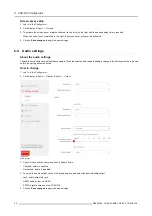
6. CSE-800 Configurator
Image 6-25
Security modes
There are 2 security modes supported by the Button to connect to the corporate network:
•
The
fi
rst one, which applies to a typical corporate network setup, is WPA2-Enterprise with 802.1X.
•
As we also want to support smaller organizations, which might have a more traditional Wi-Fi setup, there is also support for
WPA2-PSK, also known as WPA2-Personal.
Both modes are based on Wi-Fi Protected Access (WPA). We talk about WPA2, an improved version of the original WPA standard,
which adds AES encryption to improve security.
WPA2-Enterprise with 802.1X
WPA2-Enterprise relies on a server (using RADIUS) to authenticate each individual client on the network. To do this, authentication
802.1x is used (also known as port-based Network Access Control). 802.1x encapsulates the Extensible Authentication Protocol
(EAP) for use on local area networks. This is also known as “EAP over LAN” or EAPoL. Using RADIUS, these EAPoL messages
are routed through the network in order to authenticate the client device on the network – which, in the case of ClickShare, are the
Buttons.
The 802.11i (WPA2) standard de
fi
nes a number of required EAP methods. However, not all of them are used extensively in the
fi
eld,
and some other ones (which are not in the standard) are used much more often. Therefore, we have selected the most widely used
EAP methods. The list of EAP methods supported in the ClickShare system is:
•
EAP-TLS
•
PEAP
•
EAP-TTLS
Considerations
When you choose to integrate the ClickShare system into your corporate network, there are a few things to consider up front. First
of all, make sure that all your Base Units can be connected to your network via the wired Ethernet interface. Also, take into account
the amount of bandwidth that each Button needs to stream the captured screen content to the Base Unit – this is usually somewhere
between 5 and 15 Mbps. So, prevent bottlenecks in your network (e.g. 100 Mbps switches) that could potentially degrade your
ClickShare experience due to a lack of bandwidth.
Prerequisites
Before rolling out ClickShare Network Integration, make sure your infrastructure meets the following prerequisites.
Network
Once you enable the corporate network, the internal Wi-Fi access point of the ClickShare Base Unit is disabled. Make sure your
Base Unit is connected to the corporate network via its wired Ethernet interface.
Firewall
To ensure that you can successfully share content via the ClickShare Button, or from mobile devices, to the Base Unit, make sure
the ports mentioned in "Ports used by the ClickShare Base Unit", page 12are open on your network:
VLAN
A lot of corporate networks are divided into multiple VLANs – for example, to separate BYOD (Bring Your Own Device) traf
fi
c from the
“core” corporate network. Take this into consideration when integrating ClickShare into your network. ClickShare Buttons connecting
to your wireless infrastructure should be able to connect to the Base Units. Furthermore, if you want to use the mobile apps, these
should also be able to reach the Base Units. It is advisable to put all ClickShare Units into a separate VLAN so they are easily
manageable.
DNS
For the Buttons to be able to stream their content to the Base Unit, they must be able to resolve the Base Unit’s hostname within
the network. If no DNS is available Buttons will fall back to the IP of the Base Unit at the moment of USB pairing. Because of this
48
R5900049 CLICKSHARE CSE-800 19/03/2018
Summary of Contents for ClickShare CSE-800
Page 1: ...ClickShare CSE 800 Installation manual R5900049 05 19 03 2018...
Page 16: ......
Page 30: ...3 Getting started 14 R5900049 CLICKSHARE CSE 800 19 03 2018...
Page 42: ...5 Preparing the buttons 26 R5900049 CLICKSHARE CSE 800 19 03 2018...
Page 90: ...7 Software updates 74 R5900049 CLICKSHARE CSE 800 19 03 2018...
Page 94: ...8 Troubleshooting 78 R5900049 CLICKSHARE CSE 800 19 03 2018...
Page 98: ...9 Environmental information 82 R5900049 CLICKSHARE CSE 800 19 03 2018...
















































